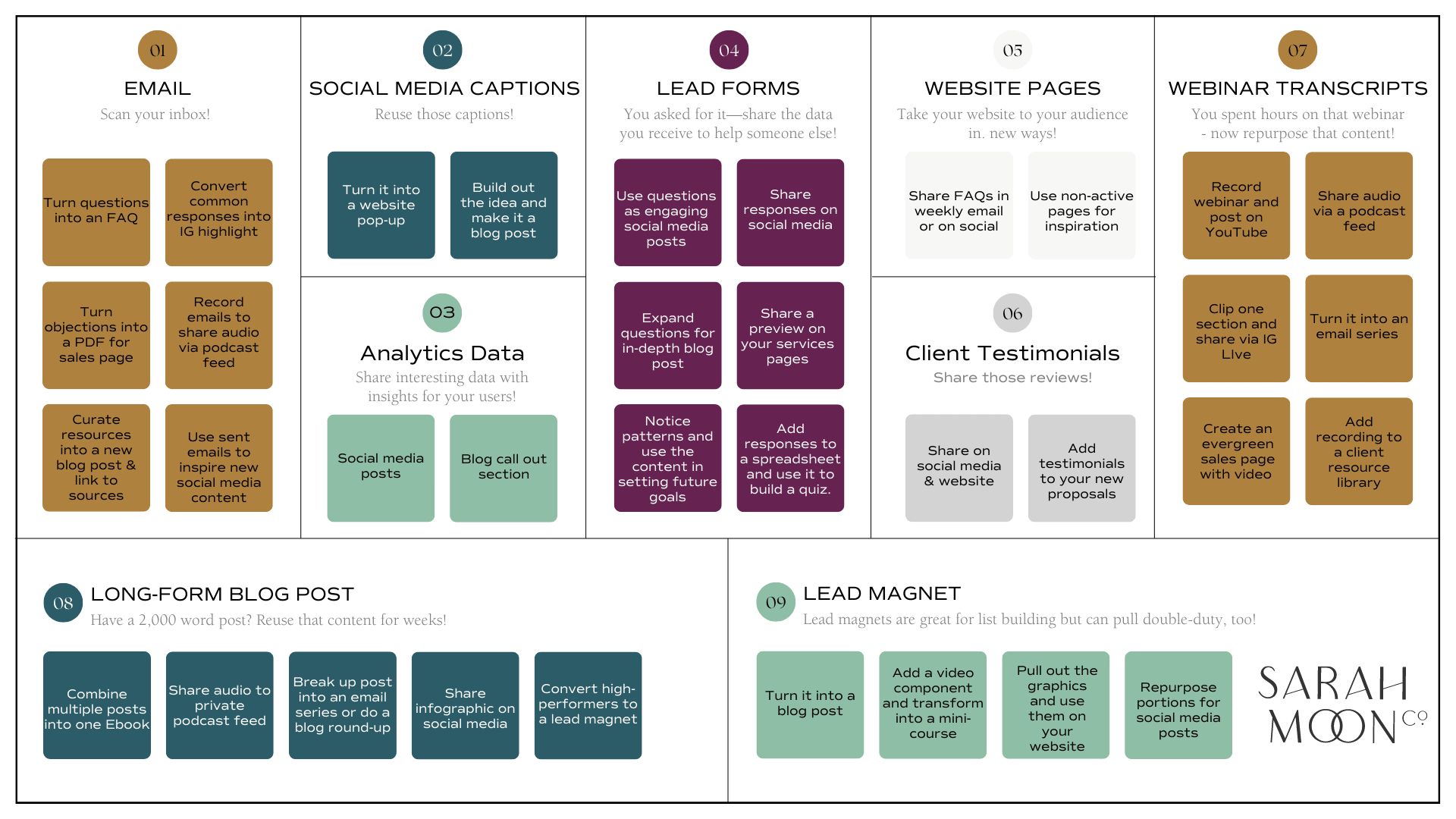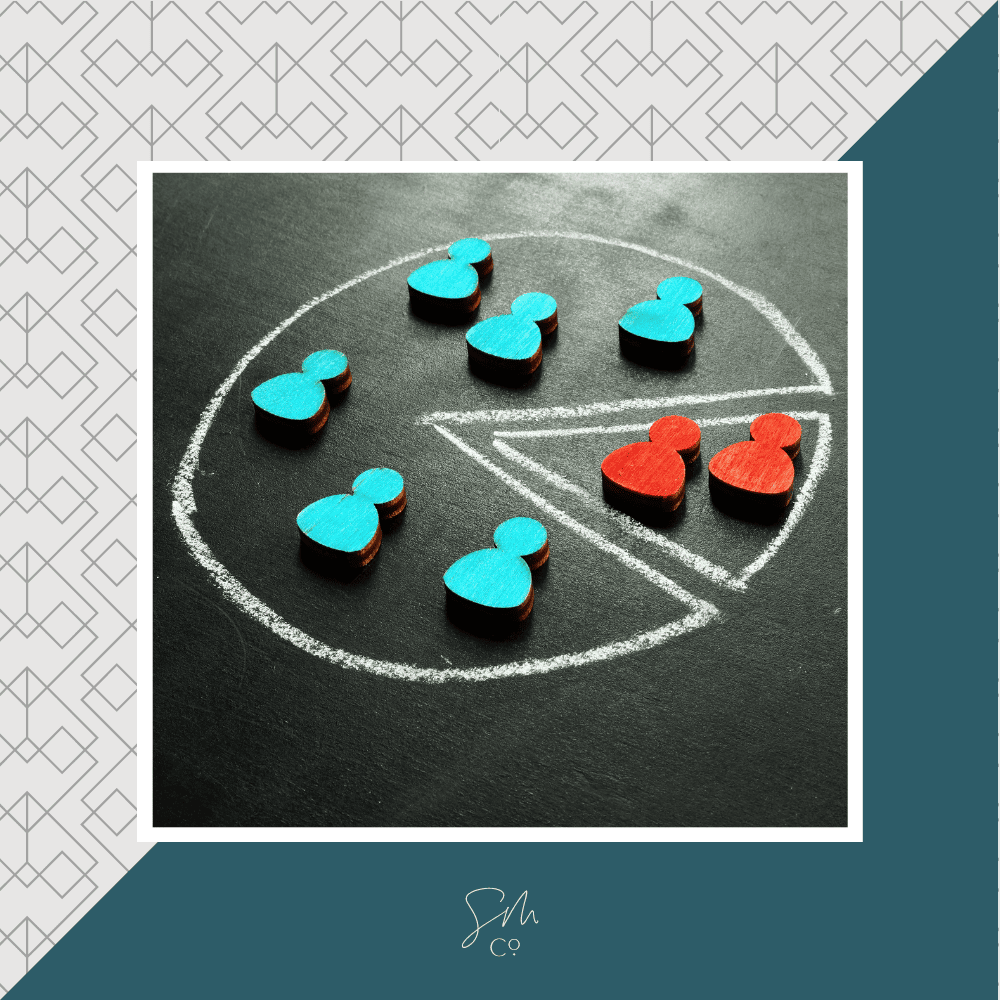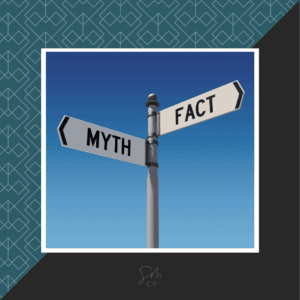- What’s the first step in content repurposing?
- What is content marketing?
- What does it mean to repurpose content?
- How to get started repurposing content
- 8 types of content you can repurpose (other than blogs)
- Six more creative ways to repurpose your content
- Content repurposing workflow: How to repurpose one piece of content every day of the week
- Key Takeaways on Repurposing Marketing Content
One of the most sustainable marketing tactics is content repurposing (or simply reusing existing content in new ways). It takes energy (all good work does). However, it doesn’t take hours upon hours of your work week, and it doesn’t have to detract from your other priorities like working with clients or taking care of customers.
Now, before you run away thinking we’re telling you to start by writing a 3,000-word blog post, don’t. That’s not the strategy or recommendation we make to our busy clients—at all. It’s not a bad idea, but it’s also not the only way to repurpose content.
Instead, we recommend focusing on mining the content you already have and using other forms of content to repurpose. For example, we’ll cover how to use the text you already have on your website for repurposing or how to take a webinar you hosted and repurpose that into a new format. By focusing on creative ways to repurpose already-existing content, even those without a current blog can get in on the fun!
If content repurposing is not part of your overall, evergreen marketing plan, you will likely experience burnout from the constant need to create new content. Plus, unless you have significant website traffic and social media followers, it’s quite possible that, if never repurposed, much of your content will never be seen.
What’s the first step in content repurposing?
Let’s break it down into really simple steps.
- Have a content marketing plan in place.
- Understand what it means to repurpose content
- Mine the content you already have using a digital asset inventory or content catalog
- Explore all the different types of content you can repurpose
- Establish a workflow to make content repurposing part of your daily marketing strategy
What is content marketing?
In its Ultimate Guide to Content Marketing, HubSpot defines content marketing this way:
“Content marketing is the process of planning, creating, distributing, sharing, and publishing content via channels such as social media, blogs, websites, podcasts, apps, press releases, print publications, and more. The goal is to reach your target audience and increase brand awareness, sales, engagement, and loyalty.”
In short and simple terms, content marketing is a strategic form of marketing where you (the business owner) are not marketing a specific product or service but rather your thought leadership. Through the content you create (written, verbal, or even graphics), you’re expressing ideas that are unique to your point of view.
Remember, studies show that 59% of decision-makers say that thought leadership is more important than marketing materials when assessing a company’s capabilities. (Read more about thought leadership here.)
When a user consumes that content, the next logical step is to seek out further resources from you and, eventually, browse your products or services with the intention of buying.
A content marketing plan is a roadmap for what types of content you intend to publish, when you’ll create them, and on what platforms you’ll share them.

What does it mean to repurpose content?
Repurposing content is as simple as using something you’ve already created in a new way. The most common type of repurposed content is taking a blog post and using the same text on another platform – a social media post, an audio feed, etc.
However, repurposed content extends far beyond a blog post. For example, we repurpose our weekly email newsletter by recording it in audio form and dropping it into a private podcast feed using Hello Audio for our podcast subscribers.
How to get started repurposing content
In nearly every source we reviewed to prepare for this article, the primary advice for repurposing centered around creating one or more long-form content pieces. (We generally think of long-form to be 2,000 words or more.)
While this makes sense (you can’t repurpose something you don’t have), our philosophy is different. As business owners, we know you don’t have an abundance of time to sit around and create a long-form piece of content every week. In fact, you may have never created a piece of long-form content at all, and that’s okay.
A better way to repurpose content is to think creatively about the different pieces of content you already have and start with that instead of creating something brand-new.
Even if you’ve never blogged before, you have content. You just may not recognize it in this way. The best way to get started repurposing content is to take an inventory of what you have and organize that content into categories that work for you.
This could be a simple Excel worksheet or a more robust Notion board – whatever works for you. You can even adapt our Digital Asset Inventory and use the Intellectual Assets tab to keep track of your blog posts, courses, workbooks, etc. (Download the tracker here for free)
By organizing the content you already have, you can quickly see what you have and more efficiently determine how to repurpose it.
For those who blog or have blogged in the past, this means, first and foremost, creating a blog post catalog. Each entry should include the blog post title, topic, live URL, and any resources or lead magnets housed within that post.
Once you’ve added all the blog content, you can move on to other types of content. Let’s look at which types of content you can repurpose other than blog posts:
Do you need to get an outside perspective on your next idea?
8 types of content you can repurpose (other than blogs)
- Client/Customer testimonials
- Lead forms questions and responses
- User-generated content
- Lead magnets
- Website pages
- Emails
- Social media captions
- Webinar transcripts
Client testimonials
You may already be repurposing client testimonials without realizing you’re doing it. For example, if you’ve ever taken a client testimonial and shared it on social media, you’ve repurposed it! Instead of creating new social media content, you used content you already had in a new way.
Other ways to repurpose client testimonials include:
- Using them on your website as social proof
- Incorporating them into your lead magnets in a highlighted box or pull-out quote
- Ask your clients to record a short testimonial using the Bonjoro app and then add these to your course or workbook welcome page
Lead form questions and responses
Even if you’re not blogging, you’re likely marketing your services and requiring potential clients to answer questions before working with you. (You might call these discovery questions, lead forms, or something else). These questions represent the core values that are important to you or demonstrate the kind of person you’d like to work with on a project.
For instance, if one of your lead form questions is, “Tell me about what change you are seeking to make in your industry,” this signals that you’re interested in working with people who want to make a difference and not accept the status quo.
So how do you repurpose lead form questions?
Lead form questions make for engaging social media posts. Using the example above, you could form an entire post around this question and ask for feedback from your followers. Or, you can use the questions to create a new piece of content that dives deeper into why this area is important to you as a business owner and how you evaluate potential clients through this lens.
Lead form responses also created excellent user-generated content. With the client’s permission, share insightful answers you received in an audio clip and post it to your Instagram Story or use it as audio for an Instagram Reel.
Turn Lead Magnets or Freebies into Reusable Marketing Content
As you go through your digital asset inventory, you will likely find a treasure trove of content inside your lead magnets.
Pro-Tip: We made a Notion board for our ConvertKit Forms to ensure we know what forms we have, what they look like, and the landing page they lead our audience to visit.
Review your lead magnets and ask yourself a few questions:
- Would a graphic inside your lead magnet work well on your website? If it needs more explanation, create an image caption to explain the information.
- Does your lead magnet have a checklist you can use as the basis for a more detailed blog post?
- Will your lead magnet translate to audio? If yes, consider turning it into a podcast episode.
Watch the replay of our Community Conversation all about maximizing audience connection with your lead magnet.
Mine Your Website Pages for Content
Take a minute to open your website platform and count how many pages you have, active and inactive. Did that number surprise you? If you’ve been in business for at least a year or two, you likely have amassed a lot of website pages you’re not currently using.
Is that content still viable, though, in other forms? For example, while you may have decided you don’t need an entire website page detailing a particular service you offer (or thought of offering), that content could translate well into a blog post, social media series, or even an email sequence.
For the active pages of your website, the content is prime for sharing in new places. For example, if you’re a website designer and have an entire page about your website design process, turn that page into a blog post that details your favorite method of designing websites.
Have a full FAQ page? Choose one FAQ to feature on your social media platform of choice every week. Better yet, add a popular FAQ to the bottom of your next email newsletter and invite readers to visit the full FAQ page for more!
Use Emails to Spark Creative Marketing
Your email inbox is full of content you can repurpose!
- What questions are you constantly answering via email? Turn those questions and answers into FAQs on your website.
- Do you find yourself repeatedly giving free advice on a particular topic? Record a quick audio clip with that same advice and save it as a highlight on your Instagram page or if you prefer video, make it into a YouTube video!
- Are potential clients responding to your proposals with reasons they’re not quite ready to work with you? Compile those responses (anonymously, of course) into a PDF with a short paragraph under each one that you can use on a future sales page or sales call.
Social media captions are a treasure trove for content marketers
Open your Instagram feed and browse through your last 10-15 posts. See all those Instagram captions you wrote? That’s valuable content sitting on someone else’s land!
Our favorite way to repurpose an Instagram post is to turn the post into a pop-up on our website. Your visitors will be delighted to see a pop-up that isn’t asking them to do anything! Instead, you’re just giving them a delightful image and helpful content!

Six more creative ways to repurpose your content
- Design infographics from blog content (infographics are great for SEO)
- Switch up the medium – video to written, written to audio, etc.
- Use analytics data in your social media posts.
- Bundle related blog posts (known as topic clusters) into an ebook and use it as a paid lead magnet
- Take an existing blog post and turn it into a workbook or checklist for a convenient list builder
- Add video training to an existing lead magnet and turn it into a digital product (we use and recommend Podia for these)
Content repurposing workflow: How to repurpose one piece of content every day of the week
It’s one thing to understand this concept and another to visualize it in progress. So, here’s an example of a content repurposing workflow that you can execute in one week.
Monday: Run your website analytics for the previous week and look for key insights. Did one post or page receive a lot of traffic? What page converted the best? Write a quick summary of your findings (spend no more than 10 minutes) and post this as a social media caption, along with a photo of your analytics dashboard.
Tuesday: Open your favorite (or only) lead magnet and scan for key takeaways or a section that will stand on its own. Create a pop-up on your website using the key takeaway text and set it to lead your lead magnet landing page.
Wednesday: Review your content catalog for a “how-to” blog post you’ve published in the past. Then, using a simple Canva template, turn those how-to steps into a checklist and share that with your email list, along with a link to your full blog post.
Thursday: Open your Instagram feed and review your captions. Is there one that really stands out and communicates a core value or message? Copy and paste that caption and send 3-4 personalized emails to potential clients you’ve not yet booked. Say something like, “I thought you might find this short message helpful in your pursuit of….. There’s no ask and no call to action – just sending helpful advice to someone who needs it.
Friday: Scan your email inbox for user-generated content. Did someone send you a nice review? Ask a good question? Use that content elsewhere today – in a social media post, as a blog post introduction, or at the beginning of an email to your list.
Key Takeaways on Repurposing Marketing Content
- Content repurposing goes far beyond breaking up a blog post into several social media posts. Yes, that’s repurposing, but that’s the very basic method.
- A content marketing strategy is critical to making repurposing work. If you don’t have a plan to create content and share it, you’ll eventually run out of ways to repurpose.
- However, you don’t have to create new content to start repurposing. Scan your inbox, files, reviews, lead magnets, transcripts, website pages, and podcast episodes to find content you can repurpose.
- If you get stuck on how to repurpose your content, default to changing the medium. So if you shared a piece of written content on your website, create an audio recording and share it that way the next time.
- Don’t limit yourself to just one piece of content at a time. Combine content of various forms and repurpose it, like bundling blog posts into an ebook, or combining written, audio, and video content into a new course.
Learn more about content marketing from these articles!
Is it possible to market your business without social media in 2024?
Are you curious about marketing your business outside of social media? Read our how to guide to doing just that!…
The No-Nonsense Guide to Hiring an SEO Expert in 2023
If you’re focused on increasing your visibility online, growing your revenue, or diversifying your lead generation, SEO is likely a…
What is movement marketing?
Movement marketing is often misconstrued and deeply misunderstood. Learn what it really means and the five fundamentals behind this marketing…
The Ultimate Guide to Identifying Your Consulting Niche (Plus: 6 In-Demand Consulting Niches for 2024)
Ready to develop an in demand and thriving consulting practice? Our guide—written by someone who’s been there, done that, walks…
The Expert’s Guide to Thought Leadership Marketing: Surprising Tips for Accelerating Your Visibility
Ready to own your voice and leverage thought leadership as a marketing strategy? Read our guide to learn how this…
How to Build a Bold Personal Brand as a Consultant
The secret to being the first and only choice in your industry? Building a bold and purposeful personal brand as…
Four Frameworks to Fuel Your Marketing & Business Strategy
Have you codified the vision for your business? If not, you’re not alone! Dig into four you can use right…
Productized Services vs Intensives vs VIP Days
Learn exactly what productized services and day rates are and how you can implement these models into your business….















 & Our Favorite Portland Coffee Shops
& Our Favorite Portland Coffee Shops
One Response
Super advice here. Think creatively about repurposing to branch out, to leverage and to go far and wide, versus narrow. I broadcast live on 2 sites and record the same content as a podcast, to spread the word for watchers and listeners. I also link in to my blog to promote my posts and online courses. Think of your blogging presence as a full spiderweb, not an individual strand.